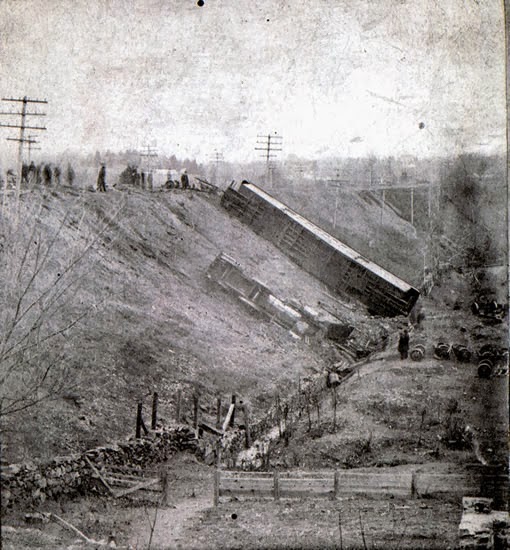New Information About Efforts to Comfort the Dying Fireman Eugene Blake After the Pelhamville Train Wreck of 1885
Home Page of the Historic Pelham Blog.
Order a Copy of "Thomas Pell and the Legend of the Pell Treaty Oak."
On December 27, 1885, the mail express train out of Boston known as the late night "Owl Train" reached Pelhamville during a major windstorm. Just as the train sailed past the Pelhamville Station, the gale lifted the station's massive wooden passenger platform into the air and flipped it onto the tracks.
Engineer Riley Phillips saw the obstruction ahead, cut the steam, and braked. It did not help. The locomotive engine smashed into the overturned platform, left the rails, and tumbled end-over-end down the 60-foot embankment, dragging the fire tender and a large mail car with it. Though the passenger cars left the rails and bounced along throwing the passengers inside about the cabins, no passenger car tumbled down the massive embankment.
Engineer Phillips and his fireman, recently-married Eugene Blake, were thrown out of the cab as it flipped end-over-end down the embankment. Phillips was bruised, but lived. Fireman Blake, however, was crushed during the incident. He was found at the foot of the embankment and was carried into the nearby Pelhamville train station. Some accounts say Fireman Blake was laid on a "cot" of some sort in the Pelhamville station. Others say he was laid on the floor.
All accounts agree, however, that once carried into the Pelhamville station, the mortally-injured Eugene Blake suffered tremendously for an agonizing forty minutes. During most of that time, he was administered to by an angel -- a woman who stepped out from among uninjured train passengers to offer help.
Only a contemporary account can truly convey the sense of the sad moments that followed. A local newspaper reported at the time:
"[A] slight woman, clad in mourning, with a face as white as snow, crept through to the cot. ‘Stand back every one of you and give him air,’ she shouted as she placed his head on her lap and gently stroked his pallid forehead. ‘Poor fellow,’ said the engineer. ‘He was only married four months ago, and . . . talked all night on this trip about the happy Christmas he had passed with his wife.’ The sufferer’s white face was as of dead for a while, when he became delirious. ‘We’ll make it, we’ll make it, Ira,’ he cried suddenly, sitting up and staring wildly around. ‘What makes you look at me so? Oh! jump, jump for your life. It’s all right, Jenny, it’s all right.’ His voice sank into a whisper with the last words, and his head fell back on the little woman’s lap. ‘He is dead,’ she said softly, placing her lace handkerchief over his face. . . ."
Source: THROWN OFF THE RAIL. Accident on the New York and New Haven Railroad., Eastern State Journal [White Plains, NY], Supplement, Jan. 2, 1886.
The "slight woman" who took charge, laid Eugene Blake's head in her lap, and placed her lace handkerchief over his face after he died, it turns out, was well known. She was Emma Cecilia Thursby, an American singer who traveled the nation giving concerts. Overnight on the evening of December 26-27, 1885, she was returning from a concert as a passenger on the Owl Train when the accident occurred.
Thursby's biographer later wrote about her involvement in the Pelhamville Train Wreck. He misplaced the time of the event, however, as late January, 1886 rather than late December, 1885. Thursby's biographer wrote:
"The new year, 1886, promised little change in the status. Without a manager in whom she could place complete confidence -- and she could not seem to find one --, although she was still in splendid voice, there seemed to be no escape from the inertia into which her career had fallen. In late January she journeyed to Rochester, New York, for her first concert of the year. Upon the return journey, she met with a serious railroad accident at Pelhamville. Fortunately escaping injury herself, she had the presence of mind, the courage, and the sympathy to go to the aid of the mortally injured fireman of the train, Eugene Blake. 'God will surely reward you,' wrote his widow to her a few days later, 'and may God be with you in all your travels throughout this world. I was married 6 short months when my Husband was torn from me and we were so Happy. Although I could not be with him myself when he breathed his last I feel thankful there was one of my sex who felt for him [Page 350 / Page 351] and stepped forward and administered such wants as would soothe a dying man.'"
Source: Gipson, Richard McCandless, The Life of Emma Thursby 1845-1931, pp. 350-51 (NY, NY: The New-York Historical Society, 1940).
A depiction of Emma Cecilia Thursby helping the dying fireman Eugene Blake appeared on the cover of the January 16, 1886 issue of The National Police Gazette published barely two weeks after the accident. Though likely an artist's rendering of what it was like that sad night, the fact remains that the image is the only known effort by anyone to depict the interior of the tiny wooden Pelhamville Station that once served Pelham commuters. It shows troubled and concerned men and women hovering as Thursby uses her handkerchief to dab the face of Eugene Blake -- the same handkerchief that she reportedly placed over Blake's face after he died in her lap.
* * * * *
Fri., Mar. 27, 2015: Compensation Paid by the Railroad After the 1885 Pelhamville Train Wreck.
Wed., Feb. 11, 2015: Coroner's Inquest Jury Found Railroad "Criminally Negligent" in the Pelhamville Train Wreck of 1885.
Order a Copy of "Thomas Pell and the Legend of the Pell Treaty Oak."
Labels: 1885, 1886, Emma Celia Thursby, Eugene Blake, Pelhamville, Pelhamville Train Wreck, Riley Phillips, train wreck

















